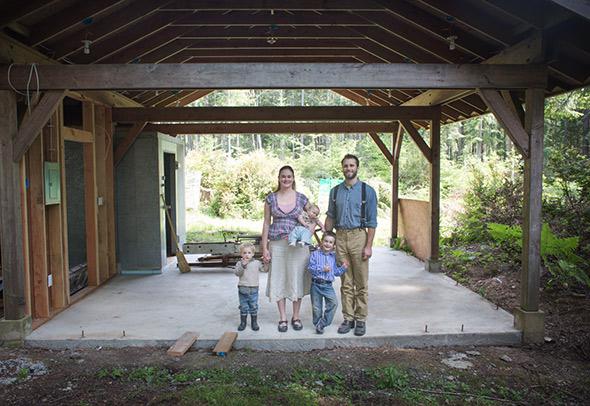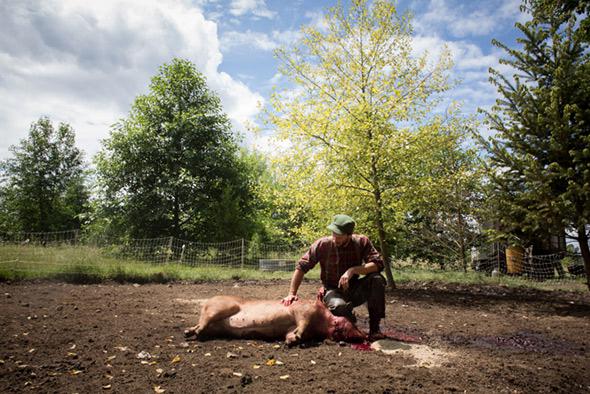Between 2011 and 2013, Brandon Sheard and Andrew Plotsky made three instructional cooking videos titled, collectively, “On the Anatomy of Thrift.” In these videos, which have been viewed 144,000 times total to date, jazzy music plays in the background as Sheard makes pork chops, rillettes, pâté, head cheese, and blood sausage. Ingredients are laid out on a heavy wooden cutting board, arranged as if for a still life painting. The scenes are artfully composed, economical, and captivating. Plotsky and Sheard are often seen laughing or smiling; they seem to be having fun.
But the jaunty aesthetic of the videos belies some of the content, which many people would find shocking. At the start of one of these videos, Sheard, who is the owner and operator of Farmstead Meatsmith, stands over a hefty black pig and swipes an X over its forehead with his index finger. He crouches down, lining up his rifle as the pig gobbles up food in a trough, and shoots it between the eyes. The pig bleeds out of the hole in its head, and then is hung over a barrel. These videos aren’t just entertaining demos of thrifty cooking—they contain graphic images of a pig being slaughtered, eviscerated, and butchered.
While these scenes are commonplace to farmers and ranchers who harvest—i.e., slaughter and butcher—their own livestock, they are relatively new to the Internet. Most online cooking videos feature charismatic chefs, simple recipes, or high stakes competitions. But this scene is changing. The Vice Munchies YouTube channel features videos like “How to Butcher and Cook Wild Rabbit.” A 28-minute video on butchering techniques received more than 800,000 views on YouTube. This trend has jumped to the big screen as well. In the first five minutes of Jon Favreau’s film Chef, the main character breaks down an entire pig.
Are videos like “On the Anatomy of Thrift,” that start with a grunting pig and end with a plate of food, just the next logical step in the world of cooking videos online? Perhaps, but they contain one thing that is still missing from the butchery and cooking videos that are slowly gaining acceptance: living animals.
Of course, living animals already have a well-secured place on the Internet. Narcoleptic cats, playful pandas, and a wide-eyed slow loris chewing a banana have millions of views on YouTube. Many people’s Twitter and Instagram feeds are filled with a seemingly never-ending supply of images of both beautifully captured food and cute animals. So what has the reception been to videos that start with cute farm animals—grunting, eating, sniffing—that are slaughtered, butchered, and turned into food porn?

Courtesy of Andrew Plotsky
I wanted to learn more about Sheard’s business, so I visited him at his home on Vashon, a small island off the coast of Seattle. Sheard lives on a small wooded property, with rabbits, pigs, and other animals in pens arranged around an open, two-story house, with his wife, Lauren, and their three young kids. He started Farmstead Meatsmith in 2010, going to small local farms that raised animals for personal consumption—two or three pigs, a small herd of goats, a handful of chickens—and harvesting the animals on site, so that the farmers would not have to ship their livestock off the island for slaughter. (Small farms that slaughter their own animals are exempt from U.S. Department of Agriculture inspection as long as they keep the meat for their own consumption.)
Around this time, the Sheards met Plotsky, a multimedia artist, who was on a cross-country trip documenting people in the food and farming business. “I cold-called him and asked if I could film him slaughter a pig,” Plotsky told me. He stayed for a few weeks, creating a film called “Blood Sausage.” Shortly after, Plotsky asked to work with Sheard, and live with him; Sheard said yes.
Plotsky wanted to make longer, instructional videos, and they started a Kickstarter campaign. In their fundraiser video, Plotsky says, “We believe good cookery is inseparable from sound slaughter practices, and that every part of an animal is delicious,” as they cut off a hoof with a snap and Sheard holds a severed pig’s head.
They planned on asking for $5,000 for the Kickstarter, but just a few hours before they launched, a friend convinced them to double the goal. They received very little press for most of the campaign—a popular food and health blog called the Healthy Home Economist covered it, and Plotsky wrote about the venture for Civil Eats—but eight days before they reached their goal, they received a small write up on Bon Appétit’s website, which featured two of their videos. On Aug. 9, 2011, they met their goal, and have raised $11,299 on Kickstarter. Most of the donations were from strangers, and all but one, from Plotsky’s own grandfather, were under $100.
Sheard and Plotsky’s goal for the videos was to change the way people think about slaughter, and how it is portrayed to the public. If, for whatever reason, you were searching for animal slaughter videos online before “On the Anatomy of Thrift” was made, you could find plenty on animal activist sites like PETA’s, of cows being abused on kill floors, pigs bleeding out in overcrowded pens, chickens debeaked and hung alive on conveyer belts. Such videos have created the perception that “when we kill an animal, it’s gross and bloody and the people are mean and the animals scream, and it’s just bad,” said Plotsky. Like shock therapy, videos from slaughterhouses intend to jar you into an intensely unpleasant emotional state and induce this reaction every time you look at plastic wrapped chicken breasts in the supermarket.

Courtesy of Andrew Plotsky
Instead of making videos where animal suffering is the whole point, Plotsky and Sheard wanted to make videos that showed killing as a small part of a larger process. “On the Anatomy of Thrift” does not shy away from the gory details. There are shots of Sheard cutting the head off of an enormous black pig, hung over a barrel as blood drips down its chin. He cuts the pig’s belly open and takes out its guts. They come out wet, sloshing and slippery, nearly falling out of his hands. Nearly all of these animal parts—which can seem repulsive in their initial incarnation—make a second appearance as food. The head is brined for head cheese, the blood is collected in a jar for blood sausage, the liver is saved for pâté. The scenes of cooking are interlaced with those of butchery, and there is some comfort in seeing the connection between the parts of the animal transformed into food.
Sheard’s approach to killing animals is carefully thought through. In the hands-on butchery classes that Sheard offers at the farms where he harvests livestock, he teaches students how to kill an animal on its own turf and according to its own nature. Pigs are “incredibly cerebral animals,” says Sheard. “They have existential crises and personal philosophies and everything. And so I think the best way to dispatch them is with a bullet to the brain.” Lambs are a different story. To reduce their anxiety, Sheard kills them in the middle of their flock, because they freak out when separated. “When they look at me, my knife doesn’t mean death, my gun doesn’t mean death. But trying to remove one from the group, that is death. You can just feel it. It’s like a shock wave through the whole herd.” So Sheard will lay the lamb on its side. When the lamb is no longer able to flee, it surrenders. “Particularly if you stroke their neck, if you manipulate their neck a little bit, which is what a predator will do. They know that signal.”
Is Sheard’s respect and empathy for animals enough to make these videos appetizing to a mass audience, to people who will regularly encounter cute animals as they scroll through Facebook and Twitter? Sheard’s videos have not gone viral, nor were they intended to. Yet they have reached a growing group of people who are interested in learning exactly where their food comes from and what it takes to bring it to their refrigerators. Sheard’s class sizes have grown beyond the usual suspects—he often has students who are vegetarians—and he has been invited across the country, as well as overseas, to talk about his work. When I went to visit him, he had just come back from a trip to London.
Some of the most surprising people who have seen his videos are children. Sheard says fans of his videos have told him “that they specifically wanted their children to see them.” Some have told Sheard that they use these videos as part of a home-schooling curriculum. Sheard has witnessed his own children’s enthusiasm for his work, particularly his 5-year-old son, Wallace. Sheard assures me that Wallace has no trouble playing with the bunnies they keep on their property and then watching as his father turns them into food. Parents who take his classes often ask Sheard at what age he let his own children watch a slaughter. “I always tell them: Wallace was on my back in the Ergo when I was shooting pigs, before he could walk,” he says. “If anyone has a problem, it’s the adults. The kids, they just get it, right away.” These early adopters just might be the generation that brings this very old method of meat production into the mainstream digital world.
